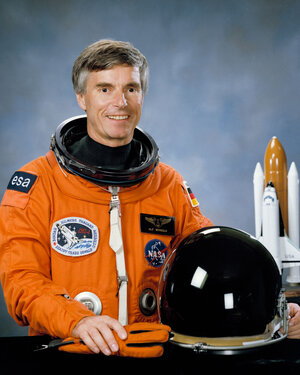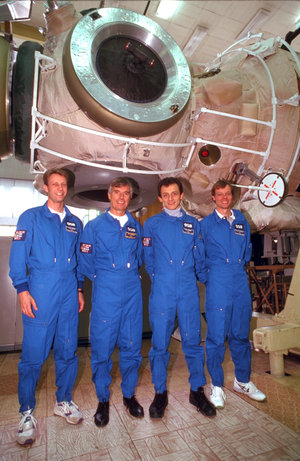EUROMIR 94
MISSION STATISTICS
Mission name: Soyuz TM-20
Call sign: Vityaz (Knight)
Number of crew members: 3
Launch:
3 October 1994, 22:42:30 UTC, Baikonur LC1
Landing:
22 March 1995, 04:04:05 UTC, 54 km NE of Arkalyk (50.52 N; 67.35 E)
Duration: 169 days, 5 hours, 21 minutes, 35 seconds
Number of orbits: ~2 760
CREW
Launched
- Alexander Viktorenko (4)
- Yelena Kondakova (1)
- Ulf Merbold (3) - ESA Germany
Landed
- Alexander Viktorenko (4)
- Yelena Kondakova (1)
- Valeri Polyakov (2)
(1) number of spaceflights each crew member has completed, including this mission
MISSION HIGHLIGHTS
20th expedition to Mir. Carried 10 kg of equipment for use by Ulf Merbold in ESA's month-long Euromir 94 experiment program. During automatic approach to Mir's front port, the spacecraft yawed unexpectedly. Viktorenko completed a manual docking without additional incident.
On 6 October 1994, Mir Principal Expedition 17 (Alexandr Viktorenko and Yelena Kondakova) arrived at Mir together with ESA astronaut Ulf Merbold aboard Soyuz TM-20, Valeri Polyakov was again to remain aboard on his record duration flight. During final approach, Soyuz TM-20 yawed unexpectedly. He assumed manual control and completed docking without incident. Kondakova, the mission rookie, was the third Russian female cosmonaut and the first female to take part in a longduration flight. Ulf Merbold was a physicist and veteran of two U.S. Space Shuttle missions.
The month-long Euromir 94 experiment program was considered a precursor to the ESA Columbus module planned for the joint U.S.-Russia-ESA-Japan-Canada space station. Merbold's program was planned rapidly, final agreement between ESA and Russian having been concluded in November 1992. It was also constrained by funding limitations -- ESA budgeted only about $60 million for Euromir 94. Because of these limitations, Merbold relied heavily on equipment left on Mir by earlier French, Austrian, and German visitors to the station, as well as the Czech-built CSK-1 materials processing furnace. He also used equipment delivered by Progress M-24 and Soyuz TM-20. Merbold's experiment program included 23 life sciences, 4 materials sciences, and 3 technology experiments.
On 11 October 1994 the six cosmonauts aboard Mir were unable to activate a video camera and TV lights while recharging Soyuz TM-20's batteries. A short circuit had disabled the computer which guided Mir's solar arrays, forcing the station to drain its batteries. The cosmonauts used reaction control thrusters on the Soyuz TM-spacecraft docked to the station to orient it so its solar arrays would point toward the Sun, and switched on a backup computer. Normal conditions were restored by 15 October 1994.
According to Yuri Antoshechkin, Deputy Flight Director for Mir Systems, speaking in December at JSC, the shortage afflicted only the Mir core module. Antoshechkin stated through an interpreter that unspecified minor crew error, coupled with a long period out of contact with monitors in the TsUP (caused by Altair/SR relay satellite 'prophylactic work') during a crew sleep period, contributed to the base block discharging its batteries unnoticed, and that an automatic alarm awakened the crew when the power shortage reached a critical level.
Ground teams rescheduled Merbold’s experiments to allow completion of those interrupted by the power problems, and moved experiments using large amounts of electricity to the end of Merbold’s stay. In addition, the Czech-built CSK-1 furnace malfunctioned, forcing postponement of five of Merbold's experiments until after his return to Earth.
On November 3 Malenchenko, Musabayev, and Merbold undocked in Soyuz TM-19 and withdrew to a distance of 190 m. They then activated its Kurs system, which successfully guided the spacecraft to an automatic docking with Mir’s aft port. The cosmonauts then went back into Mir. The test was a response to the Progress M-24 docking problems. If it had failed, the Soyuz TM-19 cosmonauts would have made an emergency return to Earth.
The Space Shuttle Atlantis lifted off from Kennedy Space Center on an 11-day atmospheric research mission on 3 November 1994. French astronaut Jean-Francois Clervoy was aboard as a mission specialist. In remarks made after Atlantis' launch, ESA Director-General Jean- Marie Luton stated that there was "a French astronaut flying on an American Space Shuttle to perform experiments from U.S., French, German, and Belgian scientists.... Meanwhile, on Russia's Mir space station, ESA astronaut Ulf Merbold is completing a month-long mission, the longest in European spaceflight. By the end of the decade, this level of cooperation will be routine aboard the international space station."
On 4 November 1994 Ulf Merbold again squeezed into the Soyuz- TM 19 descent module, together with the EO-16 crew of Yuri Malenchenko and Talgat Musabayev, and 16 kg of the life sciences samples he collected during his stay on the station. Additional samples - including materials processing samples to be produced when the Principal Expedition 17 cosmonauts carry out the experiments Merbold was to have conducted during his stay - were to be returned to Earth by Space Shuttle Atlantis in mid-1995. Soyuz TM-19 undocking, deorbit burn, reentry, and landing occurred without significant incident.















 Germany
Germany
 Austria
Austria
 Belgium
Belgium
 Denmark
Denmark
 Spain
Spain
 Estonia
Estonia
 Finland
Finland
 France
France
 Greece
Greece
 Hungary
Hungary
 Ireland
Ireland
 Italy
Italy
 Luxembourg
Luxembourg
 Norway
Norway
 The Netherlands
The Netherlands
 Poland
Poland
 Portugal
Portugal
 Czechia
Czechia
 Romania
Romania
 United Kingdom
United Kingdom
 Slovenia
Slovenia
 Sweden
Sweden
 Switzerland
Switzerland




























